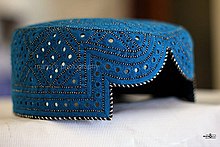Sindhi cap


The Sindhi cap also known as Sindhi topi (Sindhi: سنڌي ٽوپي , Urdu: سندھی ٹوپی) is a skullcap worn predominantly by Sindhi people of Sindh province in Pakistan, however, it has also been worn by the Saraiki people, Baloch people and Pashtuns, and can be found throughout the Pakistan. Together with Ajrak or Saraiki Ajrak, Sindhi Topi is regarded as an essential part of Sindhi culture and Saraiki culture. [1]

The hat is circular/cylindrical except for a portion cut out in the front to expose the forehead the cut in the front is shaped like a arch cut. Intricate geometrical designs are embroidered on the hat, and very often small pieces of mirror and gemstones are sewed into it. In Sindhi culture, the Sindhi topi is often given as a gift or as a sign of respect, along with the Ajrak. In December 2009, "Sindhi Topi Day" was celebrated in Pakistan's Sindh province to celebrate the Sindhi cap, and Sindhi culture in general. In 2010, the day was renamed to Sindhi Cultural Day.
Hand-woven Sindhi Topis are work of hard labour. It is usually celebrated on the first Sunday of every December. It is symbolic event to show the spirit of Sindhi culture throughout Pakistan. Sindhi Topi is primarily produced in Tharparkar, Umerkot, Sanghar, Kandhkot, Larkana, Nawabshah and some other districts of the Sindh.[2]
-
Z.A Bhutto junior
See also
References
- ^ "Archived copy". Archived from the original on 2013-11-04. Retrieved 2013-11-01.
{{cite web}}: CS1 maint: archived copy as title (link) Origins of Sindhi Topi - ^ [1] Topi Day Coverage


